Archive for February 2008
The Defeat of Time at Sonic Acts: Pitch Police says “Respect the Hertz!”
The drone. An unmanned aircraft, flying over enemy territory by itself. Secretly photographing enemy targets. Session moderator Mike Harding vividly explains to the audience at De Balie, during Sonic Acts XII, the properties of the drone, which is, in the first place, this information based weapon system. The drone now has numerous references in modern culture, of which drone music is one.
Harding pours out a hard to find drone of the midshipman fish, courtesy of BBC, which finds its source in the animal kingdom. It is what Harding calls a ‘true drone from the animal kingdom’. It is a continuous sound that doesn’t change much, but Harding is ‘not content with that definition. A sound can change radically but still retain drone qualities. There are no temporal limits on a drone, how short can a drone be? A starting point for a drone could perhaps be, that it is longer than your natural breath.’But drones are not just that. The role of the drone can also be to ‘underpin, or underscore, a composition an an essential part of the orchestra’. A drone can also be a part of a musical instrument in itself, as is evident in Leif Elggren’s Royal Organ.
Von Hausswolff
Definitions of drone music are still fluid, a member of the audience for example pointed that throat singers can not be forgotten in the discourse. But what is drone music according to its musicians? Carl Michael von Hausswolff says: ‘It is silent and beautiful, it can make you stop skiing in the middle of a forest and in that moment you achieve a certain kind of rest. A state that you would like to be in for a long time. You lose a lot of the separation that can stand between yourself as human being and nature. There are no cars rushing by and its a personal dialogue. if you want to use it as a tool for practical living: It helps me understand the processes of life and being alive’.

Von Hausswollf also mentions a connection with Gilles Deleuze and Felix Guattari: ‘There is no start, no end. A kind of eternity. You become aware of a flood in your life. It is really stimulating and perhaps a positive way of trying to… well… live’. According to Von Hausswollf, this even applies to a live performance situation, where faders tend to remind you of time. Harding responds by asking if it is perhaps a kind of metastate. Von Hausswollf: ‘If you look at a concept such as transcendental meditation. Perhaps I could do it too, but I’m too western… And I’m too f*cked up to be able to list myself. I try to find other methods to achieve this kind of calm, or… whatever’.
Nordwall
Joachim Nordwall tends to touch upon the other side of the drone music spectrum. Nordwall: ‘How do you make drone? The drone is an illusion of safety for mankind, I like to recreate a certain feeling I had when growing up. The only fun thing of growing up for me was: cheap drugs and some place me and my friend could experiment with analogue synthesizers. There was this mix of drugs and analogue drones. In my work I have realized that I wanted to recreate that room where we grew up. Yesterday (during the Paradiso performance, ed.), I wanted to fill the room with the sound. A drone is convenient to fill up the room, and filling up the room creates a kind of safety. And moreover, that specific room where life was in front of me’.

During live shows, according to Nordwall, a ‘loud volume is important and the physical aspect of the drone is very interesting. To physically feel a change can be more interesting than the mental change. You get a feeling in the stomach. You can feel some parts of the body that sometimes do not exist’. Nordwall mentions Sunn as an example of a band that is enormously loud: ‘It has an effect that will get stuck in your bones for days after’.
In the discussion afterwards, volume levels at live performances sparked an interesting discussion. Is the artist responsible for exposing people to that kind of volume? Undoubtedly, there are physical consequences of sound. However, these consequences are largely unknown to the artist. The Pitch Police says: RESPECT THE HERTZ!
Links
Crossposted at Masters of Media and Sonic Acts XII Blog
Photography by Roos Menkman – http://www.flickr.com/photos/r00s
The Diorama Revisited: Erkki Huhtamo at Sonic Acts
Erkki Huhtamo’s recent work deals with media archeology, an emerging approach he, according to his website, ‘has pioneered (together with others, like Siegfried Zielinski) since the early 1990’s’. At this edition of Sonic Acts, Huhtamo, together with the audience, revisited the concept of the Diorama. The keynote proved to be a valuable trip down memory lane with Huhtamo showing many examples and elaborating on their cultural context.
The Diorama was invented by Jacques Louis Mande Daguerre and Charles Marie Bouton and consisted of fast paintings, which were ‘slightly larger than an iMac screen’. Moreover, paintings were made in such a way that parts were translucent. In the early days, these diorama’s had to be visited and therefore it became a new element of urban landscape. Huhtamo mentions the Paris Diorama in this regard.

But why would the diorama be interesting for us, now, Huhtamo asks himself. Bruce Sterling mentioned the concept of “dead media”, Huhtamo however does not believe media is capable of dying: ‘I believe that it is more a transformation and adaptation. My research deals with understanding the materiality, discursive manifestations and how these layers coexist in culture, as the culture changes and evolves’. One of Huhtamo’s big inspirations to venture into the realm of media archeology, is the fact that artists sometimes seem to be aware of the traditions, go back to these ideas and draw inspiration from them.
In its purely mechanical form, The Diorama is a large viewing machine, an actorless optical illusion theatre, comprised of two main features, being firstly giant translucent and transforming paintings and secondly a mechnically rotating auditorium. Culturally the Diorama provided the world with a new word, a neologism, that many of these new spectacles had. The Diorama is no different, combining “dio” (transparent/through) and “rama” (view). Because it is actorless, Huhtamo sees a valuable connection between the rise of CGI possibilities and the Diorama: ‘Actors are more in the scenery’.
“rama-mania”
Continuing on the linguistics of the Diorama, Huhtamo mentions Balzac, who picked up a linguistic pattern from the hair salons and the cafes of Paris. Balzac provided his own list of “ramas”, including health-o-rama, frozenrama, soupe-au-rama and the goriorama. Images shown by Huhtamo of various Diorama’s and Daguerre’s paintings are available at R. D. Wood’s MIDLEY essays on the History of early Photography. An interesting development is the portable diorama, like the “desktop” version of the computer, the ‘huge and gigantic’ is eventually brought to the desktop.

Now, Huhtamo continues, ‘we are in the beginning of this dioramic transformation I’m trying to sketch’. Most important for this transformation is that ‘reality is not conceived as given, but as a construct. Reality as a product of new spectacles such as the diorama, panorama, wax museums, paris morgue, etc. This is the culture from which the diorama appears. In turn, Diorama’s themselves start to appear in painting’.
New Spaces and Urban Mobility
The Diorama in an urban context is ‘not like a home, but also not like the city screen outside. It is a place for the flaneur and movement in new spectacles’. Huhtamo mentions various examples of these flaneur-like places, such as the cosmorama. All share that they are about a mobile mode of spectatorship. Huhtamo: ‘The only way of viewing the panorama is to keep on walking / moving. Being physically in motion was taken over by cinema, however, the motion becomes virtual.
The audience is virtually moving with the scenes seen in the cinema’. Huhtamo sees a return to physical movement in the advent of portable devices. Interesting in the mixture of Diorama and movement is also the the idea of the “trottoir roulant”, the moving walkway, which was presented as a novelty in that time at the Paris world fair.It turned Paris into panoramic scene, the platform is enough to define the surroundings and change the identity of the surroundings
The Diorama even shaped its own popstar. Albert Smith travelled around with the moving diorama. His “hit” was ‘The Ascent of Mont Blanc’ which was shown an astonishing 2000 times. Objects used to create a reality effect include dogs and a Swiss chalet. In later years, various people played with the idea of the diorama. Examples of these include the 1939 Futurama by General Motors, which exhibited GM’s utopian vision of the world with streamlined buildings and, of course, as Huhtamo mentions, GM cars. In the futurama, the audience is traveling through the show. It is not static, like the diorama by Daguerre. The Diorama has been revisited.
Links
Crossposted at Masters of Media and Sonic Acts XII Blog
Photography by flickr.com/photos/shutenochdown
Sat Nav Mishaps for Mobile City Blog
To start things of, you can probably think of at least one satellite navigation system (sat nav) mishap. Either from your own experience, a friend’s anecdote, or from an article in the “comedy” section of your favourite newspaper. Some stories, however, are far from pleasant for the user or the environment. I wrote this post for the The Mobile City blog. It is related to my New Media MA thesis at the University of Amsterdam, for which I did a case study on “Sat Nav mishaps”, a term derived from Anthony Dunne’s reference to Mobile Mishaps in the 90s. I’ll write a more elaborate post on this subject later, as I’m still in the process of finishing the final version. I’ve also removed the draft version, which was on here for a few days as an example for the Mobile City conference. In a larger scope, the goal of the case study is to research how communication between local and global space in satellite navigation system use can be understood and, more specifically, how communication can be enabled. As we shall see, there are not just consequences for the user of the system, but also for local space and territory. The following stories show just the tip of the iceberg of Sat Nav Mishaps appearing around the globe, in repetitive fashion.
Car wrecked on railroad crossing
Paula Ceely’s story, a 20 year old student from Redditch in England, had her car wrecked after she followed her navigation system onto a railway track. Fortunately, Ceely escaped injury in the incident, otherwise the consequence of sat nav use would have been very grim. ‘I put my complete trust in the sat nav, there were no signs at all and it wasn’t lit up to warn of an oncoming train,’ Ceely told British broadcaster BBC. An article in local Welsh newspaper The Western Telegraph sparked a heated debate by locals as to whether the crossing should be made safer for drivers unfamiliar with the local. However, Paula is not unique, a similar story surfaced in the United States.
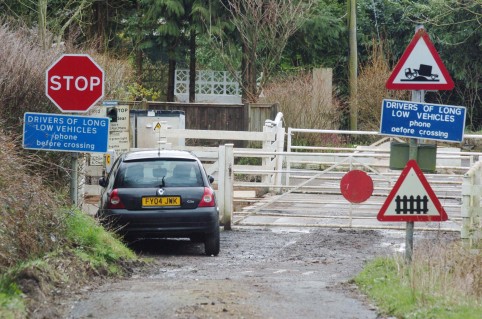
What makes Paula Ceely’s story most interesting, is that it exemplifies a locally initiated call to adjust a hazardous situation caused by sat nav. And because the mishap repeats itself, as mentioned by the locals, it tends to change existing meaning of neighbourhoods. This is not just a single case: Dutch and Belgian municipalities have filed complaints about increases in traffic moving through their residential areas.
Netherlands and Belgium: Villages file complaint against Sat Nav use
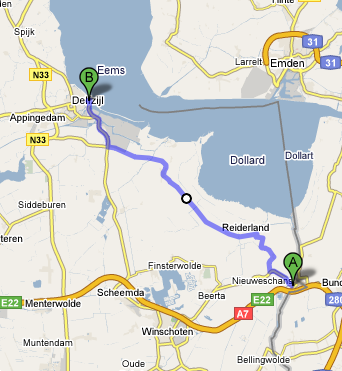
In September 2006, villages around Dutch municipality Delfzijl filed a complaint about truck drivers, mostly new to the region, using their navigation systems and causing dangerous speeding situations. On the trajectory from Nieuweschans to Delfzijl, drivers can skip fourty kilometers if they choose the shortest route algorithm. The downside is that on large parts of the trajectory the speed limit is only thirty or fifty kilometres per hour. Local Theo Nijland from the village of Woldendorp says: ‘most truck drivers usually drive eighty kilometres an hour and started to hit the breaks just before a turn’.
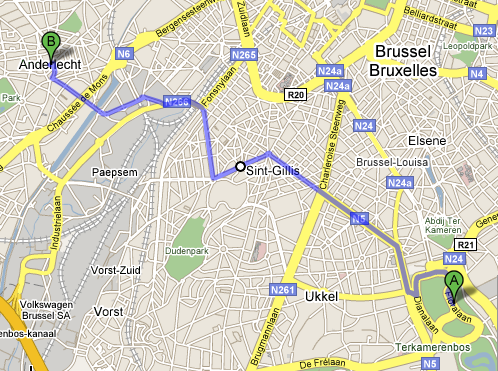
In Belgium, traffic flow through a number of villages has increased after implemention of navigation systems in traffic. In February 2007, Belgian minister of mobility Pascal Smet, in response to a complaint from the municipality of Sint-Gillis, asked nineteen municipalities around Brussels to map all conflict zones dealing with an increase in traffic due to GPS navigation. Before Sint-Gillis two other municipalities, Mortsel en Leuven, already complained about the traffic increase. Especially near schools and village centres traffic should be decreased. Similar stories have surfaced in the United Kingdom, specifically in Micklefield and Barrow Gurney.
From database error to damaging houses
The new routes not only cause a nuisance, in some cases, trucks or cars driving through villages are responsible for physically damaging the local. Villagers in English Carmarthenshire say they fear restoration work is being damaged by drivers using satellite navigation. Local residents mentioned that trucks and lorries were smashing into buildings ‘that have already had thousands of pounds spent on them’. Belgian village Meulebeke is experiencing similar damages. Because of sat nav use, heavy lorries are (illegally) driving through the center of the village. Houses have been damaged because the trucks are unable to make the turns.
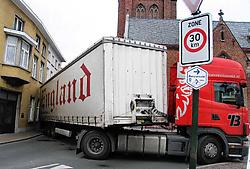
On a larger scale, English rail road company Network Rail blames drivers ‘following satellite navigation (satnav) instructions down narrow roads for a surge in damage to bridges and crossings.’ According to research done by the company, trucks have caused £15m-worth of damage in the past year ‘by striking low or narrow bridges after being directed under them by their in-cab systems.’
Seeking Solutions: Ignore your Sat Nav signs
Because of these mishaps, new ways are being sought the local to communicate with the user. A local space is being challenged, or tagged, by new meaning of global satellite navigation system use; the consequences of satellite navigation system use are similar all around the globe, as is evident in above stories. However, there seems to be an inability to communicate, or incompatibility, between spaces. The following solutions exemplify this. Firstly, there are calls for GIS database change by (local) politicians, for example in The Netherlands and the village of Barrow Gurney in the United Kingdom.
Secondly, and perhaps most interesting, is the appearing of new signs that constitute a level of acceptance into existing, dominant traffic protocol. Dutch village Roermond has put up signs to ask sat nav users to turn off their systems and follow an official detour (omleiding).
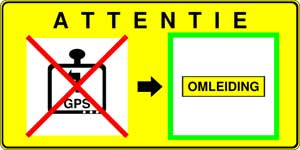
Exton, an English village, also put up a sign asking drivers to ignore their system. As local Brian Thorpe-Tracey mentions: ‘About two years ago we noticed a real increase in drivers using the lane. Vehicles are getting stuck and having to reverse back up, damaging the wall and fence. There’s even a piece of metal embedded 12ft up in a tree which looks like it’s come off a lorry.’
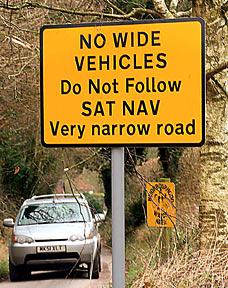
In a Welsh village, the first official British road signs to warn drivers about the dangers of trusting their sat nav. Especially foreign truck drivers navigating the region with their sat navs found themselves driving unsuitable roads.
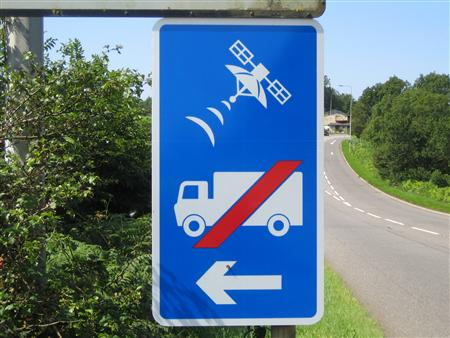
Satellite navigation systems, the most widely used GPS enabled application in consumer society today, are causing interesting mishaps and perhaps even more interesting responses by local space and traffic protocol. However, solutions, such as traffic signs and calls for database change, do not enable any dialogue between global user and local inhabitant, battling over territory’s meaning. Therefore, the interesting question remaining is: how can real-time dialogue between local and user, using global technology, be established? If the sat nav algorithm would be able to take into account emotion, for example drawing its information from an Emotion Map, a vibrant dialogue might just emerge. Sat nav algorithms, the automated decision making process of navigation, is taking on existing traffic protocol. But even Sat navs are arguing what route is the best.
